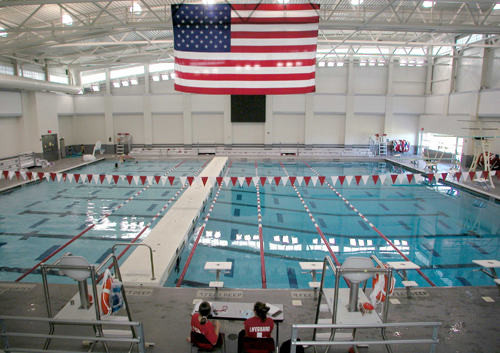College pool needs exemption from Pine Barrens Commission

Suffolk County Community College’s proposed “Health and Wellness Center” at the Eastern Campus in Northampton, a project that would include an indoor swimming pool, will need to get an exemption from the state’s Central Pine Barrens Commission before it can move forward.
The Eastern Campus, which was built in 1977, is located within the core of the Central Pine Barrens, an area where the state’s 1993 Pine Barrens Protection Act places strict limits on new development.
But the college argues that the health and wellness center was part of a 1973 college master plan for the Eastern Campus, and that many other components of that plan have been allowed to be built by the Pine Barrens Commission.
The fitness center project, which would be similar to what the college has at its Brentwood campus, would include an eight lane indoor swimming pool, fitness center, meeting space and nursing laboratory, according to George Gatta, an executive vice president at the college.
The fitness center would include a strength training room, aerobic room, gymnasium, classroom space, office space, locker rooms and lobby, according to the county.
The Suffok County Legislature has included $17.75 million for the project in its capital budget.
The college plans to make the fitness center and pool opened for use by the general public when not being used by the college. At Brentwood, the fitness center and pool have more than 1,440 members, who pay a membership fee, and the pool is also used by local high schools and swim clubs that rent it for meets, according to Mary Lou Araneo, the college’s vice president for institutional advancement.
Mr. Gatta argued at a Dec. 21 meeting of the Pine Barrens Commission that the college’s 1973 master plan for the Eastern Campus included six buildings that the Pine Barrens Commission has allowed to be built on the campus since 1995, including the 40,000 square foot Montauk Learning Resource Center, which was formally opened last year.
In order to get an exemption to build in the Pine Barrens Core, a development must qualify as “non-development” under the guidelines of the 1993 law.
One category that the Pine Barrens law does not define as “development” is “public improvements undertaken for the health, safety and welfare of the public.”
The college is arguing that the health and fitness center falls under that category.
In 1995, the college submitted its 1993 master plan for the Eastern Campus, which included the health and wellness center in a “phase two,” and which included the Montaukett building in Phase One, to the Pine Barrens Commission.
The commission, on Jan. 3, 1995, ruled that Phase One of the master plan “constitutes non-development” under the Pine Barrens Act, but it made no mention of phase two or three of the college master plan.
“We never got an explanation why phase two and three were not included,” said Louis Petrizzo, the college’s general counsel.
“The college continued to inform the commission of its plans to implement the remaining elements of the 1973-76 and 1993 master plans, as well as the 2001 master plan update,” Mr. Gatta said. They sent letters to the commission in 2005 and 2006 and have received no response or explanation why the second and third phases of their master plan didn’t receive approval.
He said the college, “receiving no response to either communication, moved forward with the planning and contraction of the Learning Resource Center and continued to plan for the implementation of the Health and Wellness Center.”
The Pine Barrens Commission is made up of the supervisors of Riverhead, Southampton and Brookhaven towns, along with one representative each from Suffolk County and New York State.
“We’ve already passed judgment that this is non-development,” said Riverhead Supervisor Sean Walter, alluding to the 1995 Pine Barrens ruling.
John Milazzo, the attorney for the commission, reminded him that the master plan was in three phases, and only the first one received commission approval in 1995.
“So, if the first phase was non-development, couldn’t we just pass a resolution at the next meeting saying this is non-development too?” Mr. Walter asked.
Richard Amper, the executive director of the Long Island Pine Barrens Society (which is not part of the pine barrens commission, although Mr. Amper was instrumental in developing the Pine Barrens Act), pointed that there were amendments to the Pine Barrens Act in 2005, and that there may be different criteria now than there was in 1995.
Mr. Milazzo concurred. He also said that the presentation at the Dec. 21 meeting was just for informational purposes, and that there is currently no formal application before the commission for the college’s plans, so they couldn’t approve them yet.
Mr. Amper later criticized commissioner members during a hearing that same day on Kent Animal Shelter’s proposal for a new shelter building at its River Road location, which needs an exception to build in the Pine Barrens core.
During that hearing, Mr. Walter praised Kent, saying they are “our defacto municipal shelter” and handle 50 percent of the dog needs for the town.
Mr. Amper said that “Kent’s providing a great public service is entirely irrelevant to the application.”
He said he’s been complaining lately that the commission members are judging applications based on whether they are a good use or provide a public service, rather then whether they meet the criteria set forth of the Pine Barrens legislation.
“Even if it were a place to honor saints, that doesn’t mean it qualifies for a hardship exemption,” Mr. Amper said.








